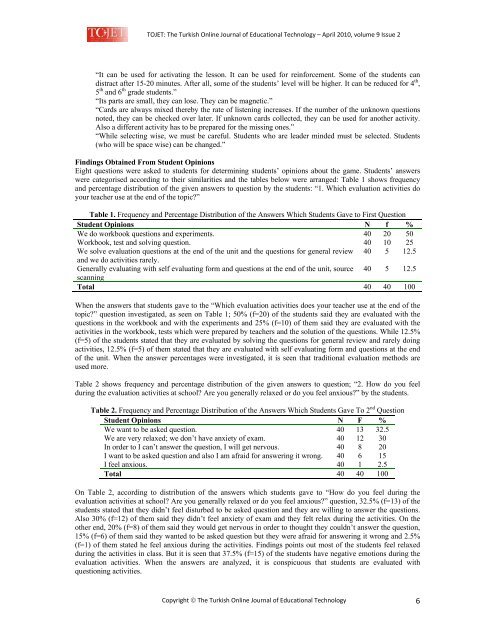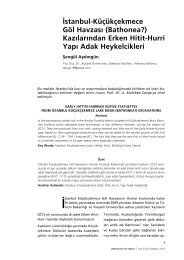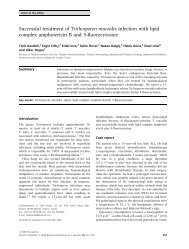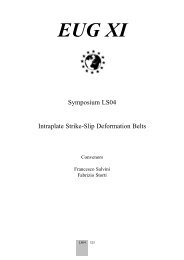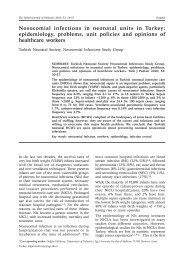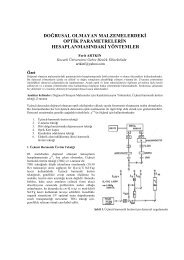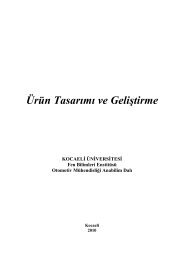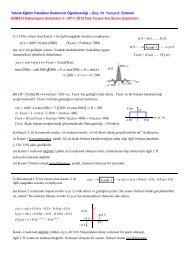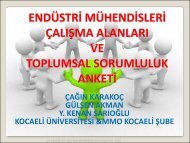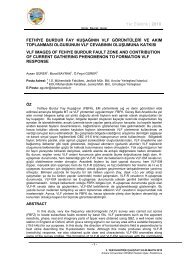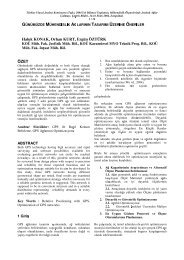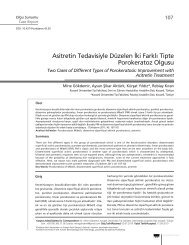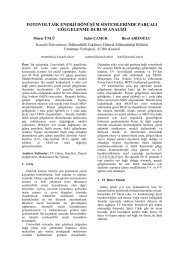a board game about space and solar system for primary school ...
a board game about space and solar system for primary school ...
a board game about space and solar system for primary school ...
Create successful ePaper yourself
Turn your PDF publications into a flip-book with our unique Google optimized e-Paper software.
TOJET: The Turkish Online Journal of Educational Technology – April 2010, volume 9 Issue 2<br />
“It can be used <strong>for</strong> activating the lesson. It can be used <strong>for</strong> rein<strong>for</strong>cement. Some of the students can<br />
distract after 15-20 minutes. After all, some of the students’ level will be higher. It can be reduced <strong>for</strong> 4 th ,<br />
5 th <strong>and</strong> 6 th grade students.”<br />
“Its parts are small, they can lose. They can be magnetic.”<br />
“Cards are always mixed thereby the rate of listening increases. If the number of the unknown questions<br />
noted, they can be checked over later. If unknown cards collected, they can be used <strong>for</strong> another activity.<br />
Also a different activity has to be prepared <strong>for</strong> the missing ones.”<br />
“While selecting wise, we must be careful. Students who are leader minded must be selected. Students<br />
(who will be <strong>space</strong> wise) can be changed.”<br />
Findings Obtained From Student Opinions<br />
Eight questions were asked to students <strong>for</strong> determining students’ opinions <strong>about</strong> the <strong>game</strong>. Students’ answers<br />
were categorised according to their similarities <strong>and</strong> the tables below were arranged: Table 1 shows frequency<br />
<strong>and</strong> percentage distribution of the given answers to question by the students: “1. Which evaluation activities do<br />
your teacher use at the end of the topic?”<br />
Table 1. Frequency <strong>and</strong> Percentage Distribution of the Answers Which Students Gave to First Question<br />
Student Opinions N f %<br />
We do workbook questions <strong>and</strong> experiments. 40 20 50<br />
Workbook, test <strong>and</strong> solving question. 40 10 25<br />
We solve evaluation questions at the end of the unit <strong>and</strong> the questions <strong>for</strong> general review 40 5 12.5<br />
<strong>and</strong> we do activities rarely.<br />
Generally evaluating with self evaluating <strong>for</strong>m <strong>and</strong> questions at the end of the unit, source 40 5 12.5<br />
scanning<br />
Total 40 40 100<br />
When the answers that students gave to the “Which evaluation activities does your teacher use at the end of the<br />
topic?” question investigated, as seen on Table 1; 50% (f=20) of the students said they are evaluated with the<br />
questions in the workbook <strong>and</strong> with the experiments <strong>and</strong> 25% (f=10) of them said they are evaluated with the<br />
activities in the workbook, tests which were prepared by teachers <strong>and</strong> the solution of the questions. While 12.5%<br />
(f=5) of the students stated that they are evaluated by solving the questions <strong>for</strong> general review <strong>and</strong> rarely doing<br />
activities, 12.5% (f=5) of them stated that they are evaluated with self evaluating <strong>for</strong>m <strong>and</strong> questions at the end<br />
of the unit. When the answer percentages were investigated, it is seen that traditional evaluation methods are<br />
used more.<br />
Table 2 shows frequency <strong>and</strong> percentage distribution of the given answers to question; “2. How do you feel<br />
during the evaluation activities at <strong>school</strong>? Are you generally relaxed or do you feel anxious?” by the students.<br />
Table 2. Frequency <strong>and</strong> Percentage Distribution of the Answers Which Students Gave To 2 nd Question<br />
Student Opinions N F %<br />
We want to be asked question. 40 13 32.5<br />
We are very relaxed; we don’t have anxiety of exam. 40 12 30<br />
In order to I can’t answer the question, I will get nervous. 40 8 20<br />
I want to be asked question <strong>and</strong> also I am afraid <strong>for</strong> answering it wrong. 40 6 15<br />
I feel anxious. 40 1 2.5<br />
Total 40 40 100<br />
On Table 2, according to distribution of the answers which students gave to “How do you feel during the<br />
evaluation activities at <strong>school</strong>? Are you generally relaxed or do you feel anxious?” question, 32.5% (f=13) of the<br />
students stated that they didn’t feel disturbed to be asked question <strong>and</strong> they are willing to answer the questions.<br />
Also 30% (f=12) of them said they didn’t feel anxiety of exam <strong>and</strong> they felt relax during the activities. On the<br />
other end, 20% (f=8) of them said they would get nervous in order to thought they couldn’t answer the question,<br />
15% (f=6) of them said they wanted to be asked question but they were afraid <strong>for</strong> answering it wrong <strong>and</strong> 2.5%<br />
(f=1) of them stated he feel anxious during the activities. Findings points out most of the students feel relaxed<br />
during the activities in class. But it is seen that 37.5% (f=15) of the students have negative emotions during the<br />
evaluation activities. When the answers are analyzed, it is conspicuous that students are evaluated with<br />
questioning activities.<br />
Copyright © The Turkish Online Journal of Educational Technology 6


